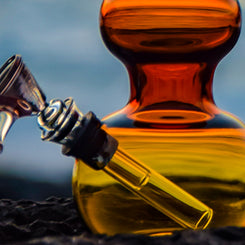Cannabis Groups
Cannabis strains are commonly broken up into three distinct groups: indica, sativa, and hybrid. Most consumers have used these three cannabis types as a touchstone for predicting effects:
- Indica strains are believed to be physically sedating, perfect for relaxing with a movie or as a nightcap before bed.
- Sativas tend to provide more invigorating, uplifting cerebral effects that pair well with physical activity, social gatherings, and creative projects.
- Hybrids are thought to fall somewhere in between the indica-sativa spectrum, depending on the traits they inherit from their parent strains.
Indica is the less scientific name for the Cannabis indica species of cannabis. Generally these plants originated in the Middle East and Asia and include both of the famous kush and Afghan lineages. Compared to their sativa counterparts, the plants are shorter, bushier and have more compact flower structure. This species tends to produce more relaxing physical effects and can have a sedative quality.
Sativa is the less scientific name for the cannabis sativa species of cannabis plant. In general, these plants originated outside of the Middle East and Asia and include strains that are from areas such as South America, the Caribbean, Africa, and Thailand. These strains tend to grow taller as plants (usually over 5 feet), are lighter in color and take longer to flower. When consumed, sativas tend to produce more cerebral effects as opposed to physical and sedative ones.
Hybrid cannabis strains are strains like Blue Dream, Jilly Bean, Dutch Treat, and Banana Kush. They are a mix (a hybrid) of the other two main classes of cannabis — “indica” and “sativa”. Hybrids often provide a more balanced combination of indica and sativa’s effects. The names “indica”, “sativa”, and "hybrid" are part of the folk taxonomy of cannabis, and they predate modern chemical quantification of the plant. The terms are often not the whole picture, but continue to be useful both to breeders, growers and consumers of marijuana.
Why should I care about indicas vs sativas vs hybrid?
Knowing what type of cannabis you are consuming can help you achieve the type of effect you might want to feel. For example, indicas are generally more sedative.
By contrast, sativas are categorized as daytime strains, because they are prone to providing an uplifting and energetic head high.
Since hybrids are a mix of sativa and indica, they can provide both mind and body effects. Most strains are hybrids. There are very few pure indicas and sativas due to global breeding programs.
Descriptions of Plant types
Cannabis Sativa
- Tall and open branched with narrow, spindly leaflets.
- Plants grow tall and are usually around 6 ft. tall.
- Flowering stage: between 10 and 16 weeks.
- Yield Size: 1.5 to 2.5 oz per plant.
- Effect: Broadly categorized as having stimulating, expansive mind-altering effects.
Cannabis Indica
- Shorter, bushier and conical in shape, with relatively wide leaflets.
- Broad and short leaves.
- Plants are short and grow between 2 and 4 ft.
- Flowering stage: between 8 and 12 weeks.
- Yield Size: 3 oz to 1 pound per plant.
- Effect: Indica strains are known for their sedating, mellow body effects.
THC vs CBD
The difference between THC vs CBD comes down to a basic difference in how each one interacts with the CB1 receptor. THC binds well with CB1 cannabinoid receptors. CBD has low binding ability with CB1 receptors.
Think of it like an electrical plug connecting to a wall socket. A THC molecule is perfectly shaped to connect with CB1 receptors. When that connection happens, THC activates, or stimulates those CB1 receptors. CBD, by contrast, is not a good fit with CB1 receptors.
The effects of cannabis vary by individual and are highly dependent on dosing and form of preparation (e.g., vapes, edibles, etc.). Most medical marijuana practitioners advise patients to start with a low dosage and gradually increase dosage as the patient determines how their body reacts.
Further complicating the issue is that THC and CBD levels — as well as THC: CBD ratios — can vary dramatically from strain to strain, so it’s important for people to be conscious of these levels.
Everyone’s body chemistry is different, so how one responds to cannabis can vary dramatically.
Terpenes
If you’ve ever used aromatherapy to relax or invigorate your mind and body, you understand the basics of terpenes. Terpenes are aromatic compounds commonly produced by plants and fruit. They can be found in lavender flowers, oranges, hops, pepper, and of course, cannabis. Secreted by the same glands that ooze THC and CBD, terpenes are what make cannabis smell like berries, citrus, pine, fuel, etc.
(SOURCE: Leafly.com)





